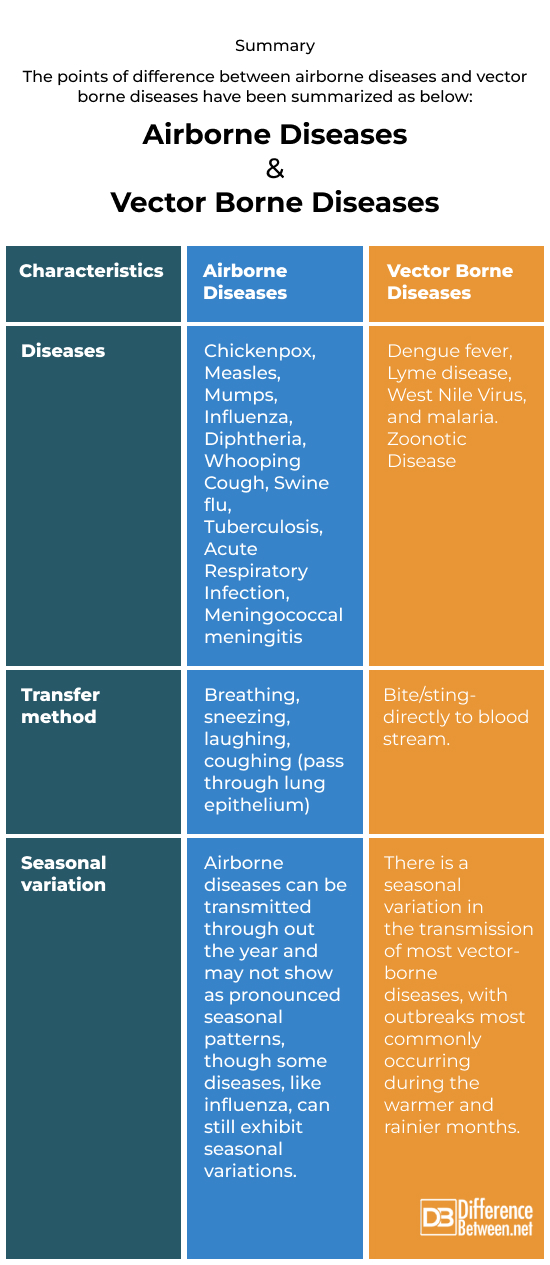Difference Between Vector Borne and Airborne Diseases
Infectious infections can spread by airborne or vector-borne routes. Diseases that are transmitted to people through the bite of an infected arthropod vector, such as a mosquito, a tick, or a flea, are known as vector-borne diseases. The disease-causing bacterium uses the vector as an intermediary carrier, multiplying inside the vector before spreading to people as the vector feeds.
Small respiratory droplets or dust particles that contain contagious bacteria are the primary means of airborne illness transmission. These particles can linger in the air and be ingested by people nearby when an infected person coughs, sneezes, talks, or even breathes.

Vector borne diseases
A disease brought on by an illness that is spread to people and other animals by anthropods (blood-feeding insects) like fleas, ticks, and mosquitoes. Dengue fever, West Nile Virus, Lyme disease, and malaria are a few examples of diseases spread by vectors.

Airborne diseases
Airborne diseases happen when infectious agents pass from one human being to another when microorganisms (pathogens) travel through the air. Coronavirus, chickenpox, influenza, are examples of airborne diseases.
These diseases get transmitted usually through coughing, sneezes, laughs, exhaling air, spraying liquid, or dust.
Different categories of airborne diseases exist. However, the symptoms, prevention, treatment, and prognosis vary according to the disease.
Similarity
Both diseases are infectious and both illnesses make human beings sick and unwell
Difference between vector borne and airborne diseases
Definition
A condition brought on by an illness that is spread to people and other animals by anthropods (blood-feeding insects) like fleas, ticks, and mosquitoes. Dengue fever, West Nile Virus, Lyme disease, and malaria are a few examples of diseases spread by vectors.
Airborne diseases
Bacteria or viruses that cause airborne infections are most frequently spread by tiny respiratory droplets. When a person with the airborne sickness sneezes, coughs, laughs, or exhales in any other way, these droplets are released. These contagious carriers can move with the flow of air, stay in the air, or adhere to surfaces before being inhaled by another person.
Symptoms
Vector borne diseases
- fever
- dengue and zika
- malaria
- headache
- Japanese encephalitis and West Nile fever
- neck pain
- Chagas disease
- muscle pain
- leishmaniasis
- joint pain
- plague
- rash
- Sleeping sickness (African trypanosomiasis)
- vomiting
- Crimean-Congo hemorrhagic fever
- diarrhea.
Airborne diseases
- inflammation of your lungs, throat, nose, sinuses
- headaches and body pains
- runny nose and nasal congestion
- tiredness
- increased sputum production
- fever
- sneezing & coughing
- sneezing
- congestion
- sore throat
- swollen glands
- loss of appetite
Causes
Vector borne diseases
These are caused by viruses, bacteria, and other parasites transmitted by the vectors (a DNA molecule used as a vehicle to transfer foreign genetic material into another cell)
Airborne diseases
Caused by pathogenic microbes – bacteria or viruses that are transmitted through airborne sources like sneezes, breathing, coughing, and laughing or otherwise exhales in some way.
Treatment
Vector borne diseases
- Vaccines to prevent vector-borne diseases like yellow fever (the vector mosquitoes Aedes aegypti), Japanese encephalitis, and tick-borne encephalitis.
- Malaria can be treated with medicines like quinone
- Antibiotics like doxycycline (a tetracycline antibiotic) and chloramphenicol treat bacterial infections like plague.
Airborne diseases
- Anti-virals
- Antifungal medications
- A combination of antibiotics
- Antitoxins
Prevention
Vector borne diseases
- Use pest repellent lotions, creams, medicated coils and mats etc.
- Use sleeping nets especially for babies and small kids during day time to avoid mosquito bite
- Prevent collection of stagnant water
- Cover water containers tightly and keep changing water in them frequently
- Wear full clothes (full sleeved shirts, gloves and full pants with long socks)
Airborne diseases
- Cover your mouth when you are either soughing, sneezing, laughing or anyways exhaling infectious breath
- Wash your hands frequently especially after sneezing or coughing
- Avoid touching your face frequently
- Regularly cleaning and servicing ventilation systems
Summary
The points of difference between airborne diseases and vector borne diseases have been summarized as below:

FAQ:
What is the difference between airborne and direct contact diseases?
Airborne diseases can spread through contact in the air or physical touch. Airborne infections happen when germs are floating in the air as tiny particles or droplets, which can be inhaled by people close to someone who is infected or in a place with the contagious agent. Instances of airborne diseases include COVID-19, the flu, and tuberculosis.
Illnesses transmitted through direct contact occur when an infected person touches a vulnerable individual. This can include skin-to-skin touch, contact with body fluids, or contact with surfaces or objects that are contaminated. Direct contact can result in the transmission of infection.
What is the vector of an airborne disease?
- The common cold – vector is rhinovirus
- Chickenpox – vector is Varicella zoster virus
- Mumps – vector is paramyxovirus
- Measles – vector is paramyxovirus
- Whooping cough – vector is Bordetella pertussis
- COVID-19 – vector is SARS-CoV-2 virus
- Aspergillosis vector is Aspergillus fungus
- Tuberculosis (TB) – vector is bacterium Mycobacterium tuberculosis
- Anthrax – vector is Bacillus anthracis spores
- Diphtheria- vector is Corynebacterium diphtheriae
- Meningitis – vectors include bacterial, viral, or fungal particles
What is the difference between a vector-borne disease and a vehicle borne disease?
There are two categories of contagious illnesses—diseases transmitted by vectors and diseases transmitted by vehicles. An individual may contract a vector-borne disease by being bitten by an infected vector organism.
The vector acts as an intermediate host, facilitating the transfer of the virus. Common carriers include mosquitoes (responsible for diseases like malaria, dengue, and the Zika virus), ticks (responsible for Lyme disease), and fleas (responsible for bubonic plague). In many diseases, the virus replicates within the vector before spreading to a new host.
Contaminated food, water, fomites, and infected air transmit vehicle-borne diseases.
The vehicle itself carries disease-causing agents (pathogens) in these illnesses.
Examples include salmonella infection from tainted food, cholera from contaminated water, and tuberculosis spread through respiratory droplets.
The pathogen responsible for vehicle-borne infections does not reproduce or grow inside the car. It simply exists there and can be transmitted to new hosts through ingestion, contact, or inhalation.
What is an example of an airborne disease?
An example pf airborne disease is Chickenpox also called as varicella. It is a super contagious viral infection which shows symptoms like itchy, discomforting blister-like rash on the skin.
What are the 4 airborne diseases?
The four airborne diseases include:
- Pertussis (whooping cough)
- Chickenpox
- Respiratory Syncytial Virus (RSV)
- Influenza
What are the 4 types of disease transmission?
- Respiratory (droplet) transmission
- Airborne transmission that happens when infection causing agents are transported by dust suspended in the air
- Food or water transmission
- STDs which mean Sexually transmitted diseases
- Insect or animal transmission
- Health care transmission
- Difference Between Global Warming and Greenhouse Effect - May 18, 2024
- Difference Between Vaccination and Immunization - March 3, 2024
- Difference Between Selective Mutism and Autism - February 25, 2024
Search DifferenceBetween.net :
Leave a Response
References :
[0]Aliabadi, A. A., Rogak, S. N., Bartlett, K. H., & Green, S. I. (2011). Preventing airborne disease transmission: review of methods for ventilation design in health care facilities. Advances in preventive medicine, 2011.
[1]Gubler, D. J. (2009). Vector-borne diseases. Revue scientifique et technique (International Office of Epizootics), 28(2), 583-588.
[2]Sood, S. K., Rawat, K. S., & Kumar, D. (2023). Emerging Trends of ICT in Airborne Disease Prevention. ACM Transactions on Internet Technology, 22(4), 1-18.
[3]World Health Organization. (2014). Vector-borne diseases (No. SEA-CD-300). WHO Regional Office for South-East Asia.
[4]Image credit: https://www.canva.com/photos/MAEJCS8zBwk-scientific-clinical-lab-research-for-an-infectious-airborne-disease-image-series-during-corona-virus-pandemic/
[5]Image credit: https://www.canva.com/photos/MAD4l6mYGAg-the-concept-of-protection-against-airborne-diseases-pills-or-capsules-on-a-disposable-surgical-mask-over-blue-background-/
